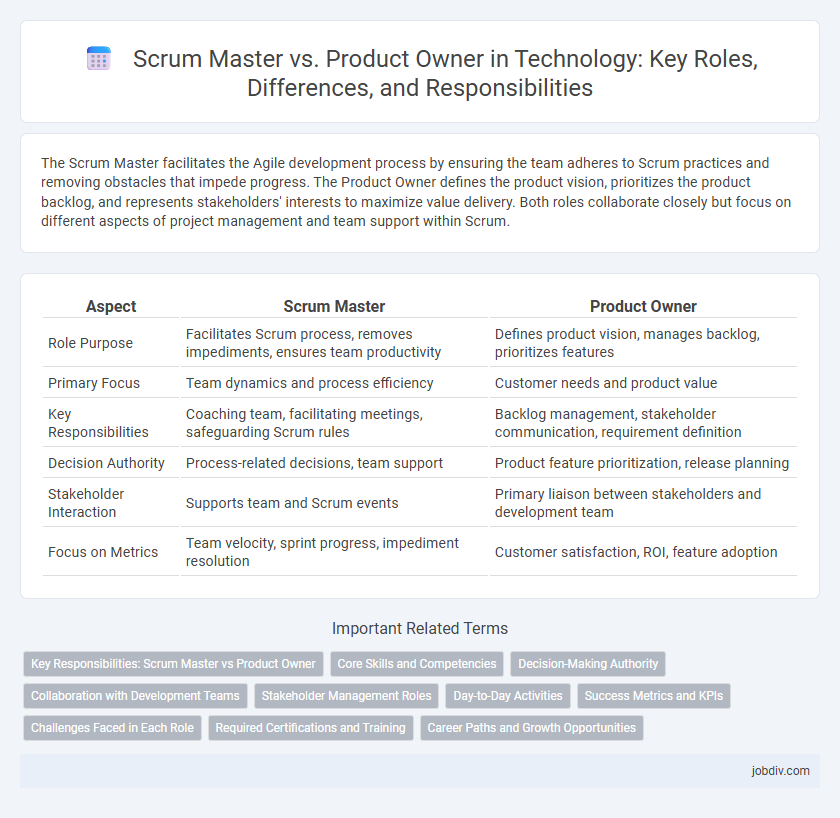The Scrum Master facilitates the Agile development process by ensuring the team adheres to Scrum practices and removing obstacles that impede progress. The Product Owner defines the product vision, prioritizes the product backlog, and represents stakeholders' interests to maximize value delivery. Both roles collaborate closely but focus on different aspects of project management and team support within Scrum.
Table of Comparison
| Aspect | Scrum Master | Product Owner |
|---|---|---|
| Role Purpose | Facilitates Scrum process, removes impediments, ensures team productivity | Defines product vision, manages backlog, prioritizes features |
| Primary Focus | Team dynamics and process efficiency | Customer needs and product value |
| Key Responsibilities | Coaching team, facilitating meetings, safeguarding Scrum rules | Backlog management, stakeholder communication, requirement definition |
| Decision Authority | Process-related decisions, team support | Product feature prioritization, release planning |
| Stakeholder Interaction | Supports team and Scrum events | Primary liaison between stakeholders and development team |
| Focus on Metrics | Team velocity, sprint progress, impediment resolution | Customer satisfaction, ROI, feature adoption |
Key Responsibilities: Scrum Master vs Product Owner
The Scrum Master facilitates the Agile process, removing impediments and ensuring team adherence to Scrum practices, while the Product Owner defines the product vision, prioritizes the backlog, and bridges stakeholder requirements with the development team. Key responsibilities of a Scrum Master include team coaching, sprint planning support, and process improvement, whereas the Product Owner focuses on maximizing product value through backlog management and stakeholder engagement. Effective collaboration between these roles ensures timely delivery, quality outcomes, and alignment with business goals.
Core Skills and Competencies
Scrum Masters excel in facilitation, conflict resolution, and servant leadership, ensuring team collaboration and adherence to Agile principles. Product Owners possess strong skills in stakeholder management, vision setting, and prioritizing product backlogs to maximize value delivery. Both roles require effective communication and deep understanding of Agile frameworks to drive successful project outcomes.
Decision-Making Authority
The Scrum Master facilitates team collaboration and removes impediments but does not hold decision-making authority over product direction or priorities. The Product Owner has the exclusive authority to make decisions regarding the product backlog, prioritization, and release planning to maximize product value. Effective Agile teams rely on clear boundaries where the Product Owner drives product decisions while the Scrum Master ensures smooth process execution.
Collaboration with Development Teams
Scrum Masters facilitate collaboration by removing impediments and ensuring effective communication between development teams and stakeholders, fostering a productive Agile environment. Product Owners prioritize the product backlog, clarify requirements, and align development efforts with business goals to maximize value delivery. Both roles actively engage with development teams to enhance transparency, encourage feedback, and drive continuous improvement throughout the Sprint cycles.
Stakeholder Management Roles
The Scrum Master ensures smooth communication and collaboration among stakeholders by facilitating meetings and removing impediments, fostering a transparent and productive environment. The Product Owner prioritizes stakeholder requirements and feedback to shape the product backlog, aligning development efforts with business goals and customer needs. Both roles are critical for stakeholder management but focus respectively on process facilitation and value delivery.
Day-to-Day Activities
The Scrum Master facilitates sprint planning, daily stand-ups, and retrospectives, ensuring the team adheres to Agile principles and removes impediments. The Product Owner prioritizes the product backlog, defines user stories, and collaborates closely with stakeholders to align development with business goals. Both roles engage frequently but focus respectively on team dynamics and product value delivery within Agile frameworks.
Success Metrics and KPIs
Scrum Master success metrics emphasize team velocity, sprint goal completion rate, and impediment resolution time, which directly impact agile process efficiency. Product Owner KPIs focus on product backlog health, customer satisfaction scores, and release predictability, highlighting value delivery and stakeholder alignment. Both roles drive project success through distinct yet complementary performance indicators essential for agile team effectiveness.
Challenges Faced in Each Role
Scrum Masters often face challenges in facilitating team collaboration, resolving conflicts, and ensuring adherence to Agile practices without overstepping authority. Product Owners struggle with prioritizing the product backlog, managing stakeholder expectations, and delivering clear, actionable user stories that maximize product value. Both roles require strong communication skills and the ability to balance competing demands in fast-paced development environments.
Required Certifications and Training
Scrum Masters typically pursue certifications such as Certified ScrumMaster (CSM) or Professional Scrum Master (PSM) to validate their expertise in facilitating agile processes and team collaboration. Product Owners often obtain certifications like Certified Scrum Product Owner (CSPO) or Professional Scrum Product Owner (PSPO) to demonstrate proficiency in backlog management, stakeholder engagement, and product vision alignment. Both roles benefit from continuous training in agile methodologies, leadership skills, and domain-specific knowledge to ensure effective project delivery and value maximization.
Career Paths and Growth Opportunities
Scrum Masters typically advance toward roles in agile coaching, project management, or organizational change leadership by enhancing their expertise in team facilitation and agile methodologies. Product Owners often progress into product management, business analysis, or strategic leadership positions, leveraging skills in market analysis and stakeholder communication. Both career paths offer growth opportunities in scaling agile practices across departments or entire enterprises, with certifications like Certified ScrumMaster (CSM) and Professional Scrum Product Owner (PSPO) boosting career development.
Scrum Master vs Product Owner Infographic

 jobdiv.com
jobdiv.com